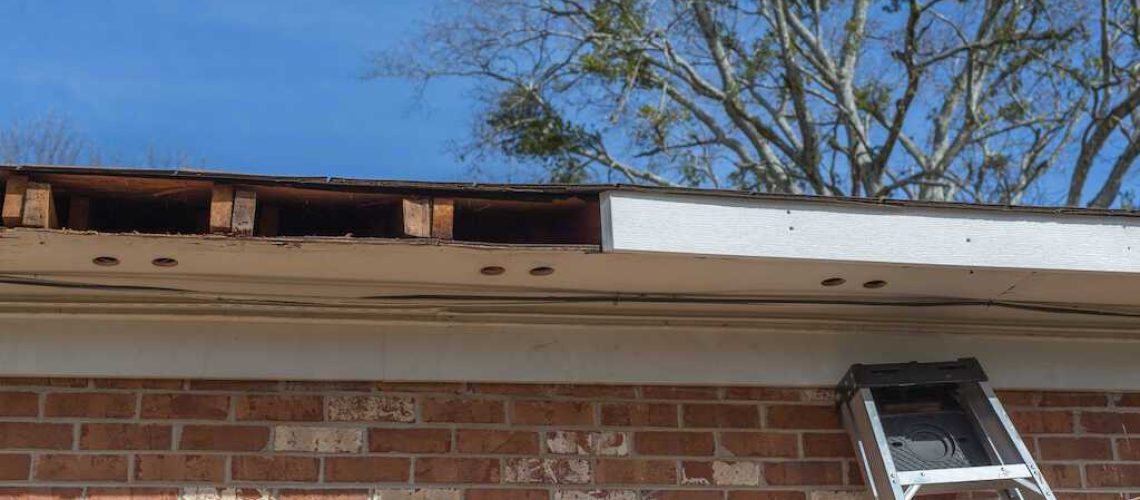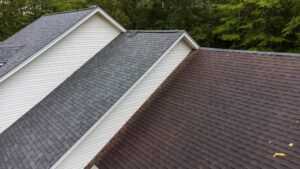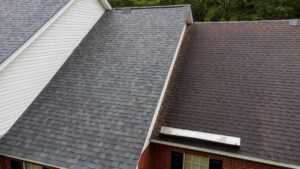Are your gutters constantly clogged, causing potential damage to your home? Even if they’re not overflowing with leaves and yard debris today, not keeping gutter clean can mean problems down the road.
Don’t worry, we’ve got you—and your gutters—covered!
We’ll show you how easy it is to install DIY gutter guards. They’re a cost-effective solution to protect your gutters from debris buildup. With our step-by-step instructions, get ready to enjoy worry-free gutters that keep leaves, twigs, and other debris from clogging your gutters and downspouts.
Why You Need Gutter Protection
Gutters direct water away from the foundation, preventing damage to your walls, landscaping, and basement. When gutters become clogged, water can’t flow properly, leading to potential damage to your home.
Common problems caused by clogged gutters include:
- Water overflow
- Standing water
- Roof damage
Anytime you ignore clogged gutters, you’re putting your home at risk. Water overflow can result in wood rot and damage to your home’s foundation. Standing water is an open invitation for mosquitoes and other pests.
Clogged gutters can also cause damage to your roof due to water seeping under the shingles. Over time, you may notice roof leaks.
Gutter guards prevent debris from accumulating in your gutters. You won’t need to muck out the gutters as often. You might also be able to extend the life of your gutter system.
Types of Gutter Guards
There are several different types of gutter guards. Understanding their pros and cons will help you select the most suitable option. Here are the main types to consider:
Mesh Gutter Guards
Made of fine mesh material, these guards allow water flow while blocking larger debris like leaves and twigs. Smaller debris may still penetrate the mesh, requiring occasional cleaning.
Reverse Curve Gutter Guards
Designed to let water flow around a curve while debris falls off, these guards have a smooth surface that sheds leaves and branches. They work well in heavy rainfall areas but may need periodic maintenance for smaller debris removal.
Bottle Brush Gutter Guards
Consisting of bristles placed inside the gutter, these guards prevent large debris while allowing water flow. Regular cleaning may be necessary to remove smaller debris caught in the bristles.
Foam Gutter Guards
Made of porous foam that blocks debris but allows water passage, this type of gutter guard is easy to install. They can even withstand extreme temperatures. Foam gutter guards do need occasional cleaning to prevent clogging and mold growth.
Snap-in Gutter Guards
Made of vinyl or aluminum, you install these guards by snapping them onto the gutter. They offer a simple and cost-effective solution but may not be as durable as other options.
Consider factors such as your local climate, the type and amount of debris, and your budget when choosing a gutter guard. Also, think about maintenance requirements and ease of installation. To make the best-informed decision, it’s wise to consult with a roofing contractor.
Tools and Materials Required
To successfully install DIY gutter guards, you’ll want to gather the necessary tools and materials before you start the project.
Here’s your tool list:
- Measuring tape
- Scissors or utility knife
- Screwdriver or drill
- Ladder or scaffolding
- Safety gloves and goggles
- Cleaning tools
- Sealant or adhesive
The last two items aren’t exactly intuitive. But leaving them off the list could mean extra trips to the hardware store.
Before installing new gutter guards, you’ll need a scoop, brush, or pressure washer to thoroughly clean the gutters of any debris. Some installations may require sealant or adhesive to ensure a secure fit and prevent water leakage.
Once you choose your gutter guards, your roofing contractor can provide more details on any other tools or materials you may need. If your contractor offers pressure washing services, or can refer you to a contractor they know, you may be able to take advantage of knocking out more than one project.
Tips for Finding Tools for the Project
What if you don’t have all the tools for your project? Sure, your neighbor might have just what you’re looking for, but maybe you’d like to add to your home maintenance toolbox. Here are a few ideas:
Shop Local
Check your local hardware stores or home improvement centers. These stores often carry a wide selection of gutter guards and the tools needed for installation.
Visit them in person to see the products up close. This allows you to talk face-to-face with a store employee who can help you choose the right tools.
Gutter Guard Suppliers
There are dedicated suppliers that specialize in gutter guards and related tools. These suppliers often have a comprehensive selection of products designed specifically for gutter protection.
Exploring their websites or contacting them directly can help you find high-quality tools tailored to your gutter system.
DIY Websites and Forums
Visit websites and forums dedicated to DIY home improvement. Online communities focused on DIY projects can be a valuable resource. Usually, there’s a wealth of recommendations and advice on the best tools and materials.
This firsthand knowledge can help you make more informed decisions and discover tools that may not be as widely known.
By using these tips, you may find it easier to locate the tools you need for your DIY gutter guard project. Any of these options offer opportunities to compare, gather information, and make well-informed choices.
Are There Alternative Tools?
Perhaps you’re a new homeowner and haven’t had the chance to buy a good ladder. Consider renting one from a local equipment rental store or borrowing from a friend or neighbor who has a sturdy and reliable ladder.
If you decide to use scaffolding, try a local equipment rental store. Larger home improvement stores, construction and building supply stores, and online marketplaces often carry scaffolding.
Ensure that whichever option you choose meets the necessary safety standards and provides proper stability during use. Avoid using homemade ladders or scaffolding.
Instead of purchasing specialized cleaning tools for your gutters, there are alternative options that can get the job done effectively. A garden hose with a high-pressure attachment can help dislodge debris from your gutters. You can also repurpose common household items like a small trowel or a stiff brush to manually remove debris and unclog the gutters.
By considering these alternatives, you can still proceed with your DIY gutter guard project even if you don’t have access to certain tools or materials. Renting, borrowing, or improvising with household items can provide viable alternatives to get the job done.
Always prioritize safety throughout the process.
Remember to follow the manufacturer’s instructions for the gutter guards and exercise caution when using any tools or equipment. With the right tools and materials at your disposal, you’ll be well-prepared to streamline the installation process and achieve a successful outcome for your DIY gutter guard project.
Prepping for Installation
If you’ve decided to install gutters guards on your own, you’ll need to prepare for the installation. Before installing gutter guards, it’s vital to thoroughly clean your gutters. Cleaning the gutters helps remove debris and allows for smooth water flow.
Here’s a step-by-step guide on how to clean your gutters effectively:
Put on safety gloves and goggles. Set up your sturdy ladder or scaffolding. Grab a scoop, a brush or high-pressure hose attachment, and a bucket or tarp for debris collection.
Make sure the ladder or scaffolding is on a stable and level surface. Consider having a helper nearby for added stability and safety.
Begin near the downspout and use the scoop to remove large debris, such as leaves and twigs, from the gutter. Place the debris in the bucket or on a tarp for easy disposal.
Scrub the gutters with a brush to remove dirt and grime. You can use a high-pressure garden hose attachment. Some homeowners prefer a pressure washer, so that they get a high enough level of pressure to remove any residue or stuck-on grime.
Start at one end and work your way towards the downspout, directing the flow of water towards the downspout as you clean.
Use the scoop to clear any clogs or blockages in the downspout. Make sure water can flow freely through the downspout.
After cleaning, inspect the gutters for any signs of damage or loose brackets.
If you need a gutter repair it’s best to take care of it before installing the gutter guards. It’s possible that you’ll need to consider replacing gutters—or at least the damaged gutter sections—before proceeding with the installation of gutter guards.
Safety During Preparation
Whether you’re in a hurry to get the job done, or you’re a new DIYer, safety is paramount. It’s one of those things many people don’t give much thought to before starting a home improvement project.
Here are a few tips that will help ensure you have a safe and stable working environment:
- Always use a sturdy ladder or scaffolding
- Secure ladders and scaffolding properly
- Have a spotter or helper nearby to assist
- Wear safety gear—including gloves and goggles
- Take breaks as needed
- Steer clear of electrical wires
- Stay hydrated
- Avoid overreaching
- Avoid leaning too far to maintain balance
By following these steps and safety tips, you can effectively prepare your gutters for the installation of gutter guards. These safety tips also work for the rest of the installation process. Whatever your level of DIY expertise is, knowing what to do in an emergency is also critical.
DIY Gutter Guards Installation Process
Installing gutter guards is a straightforward process. Most DIYers can complete the project with a few simple steps.
Here’s a detailed guide to help you through the installation:
Step 1: Measure and Prepare
Start by measuring the length of your gutters accurately. This will determine the amount of gutter guard material needed.
Clear any debris from the gutters and ensure they are clean and dry before installation.
Step 2: Cut the Gutter Guard Material
Using scissors or a utility knife, carefully cut the gutter guard material to match the measured length of your gutters. Make clean, straight cuts to ensure a precise fit.
Step 3: Position the Gutter Guard
Place the cut gutter guard section on top of the gutter, aligning it with the edge. Ensure it covers the entire length and width of the gutter.
Some gutter guards come with clips or brackets for securing them in place. If applicable, attach these according to the manufacturer’s instructions.
Step 4: Secure the Gutter Guard
Depending on the type of gutter guard, you may need to use a screwdriver or drill to secure it in place. Follow the provided guidelines to attach the guard securely.
Make sure the gutter guard sits snugly and does not sag or block water flow.
Step 5: Repeat for the Remaining Sections
Repeat the cutting and installation process for each additional gutter guard section until you have covered all the gutters. Double-check that each section is aligned correctly and securely fastened.
Step 6: Inspect and Make Adjustments
Inspect the installed gutter guards. Ensure they are evenly spaced, securely attached, and provide complete coverage. Make any necessary adjustments or tighten any loose fastenings as needed.
Step 7: Clean Up the Mess
Dispose of any leftover materials and clean up the work area. While this step should be a given, if you’re exhausted after installing the gutter guards, it’s easy to put off cleanup until later. Cleaning up immediately after finishing your project eliminates risk of injuries from sharp tools or pieces of gutter.
Is DIY Gutter Guards the Project for You?
Installing gutter guards is a practical and cost-effective solution to safeguarding your gutters and preventing potential damage to your home. By taking the DIY approach, you can experience several benefits while ensuring the long-term health of your gutter system.
One of the key advantages of DIY installation is the sense of accomplishment and savings it offers. If you follow the steps we’ve shared, you can tackle the project with minimal fuss.
There’s nothing like completing a home maintenance project on your own terms. At the end, you get to enjoy the satisfaction of a job well done.
There is a caveat.
Not everyone feels confident about tackling this type of home maintenance project. If you don’t feel comfortable taking the DIY route, don’t hesitate to contact a professional roofing contractor. They have the expertise and tools to ensure a seamless installation and can provide valuable guidance on selecting the right gutter guard system for your home.
Let Us Install Your New Gutter Guards
Take action now to protect your gutters. Don’t let debris and clogs compromise your home’s foundation and structural integrity. DIY gutter guards can save time and money.
If you prefer to let a professional roofing contractor do the job, the experts at Freeman Exteriors are here for you. We’re the preferred roofing company for home and business owners in Champaign County, Vermilion County, and the surrounding areas.
Contact us today to discuss your options and get started on the path to a well-protected gutter system. We’d love to help you get started with a free estimate.




